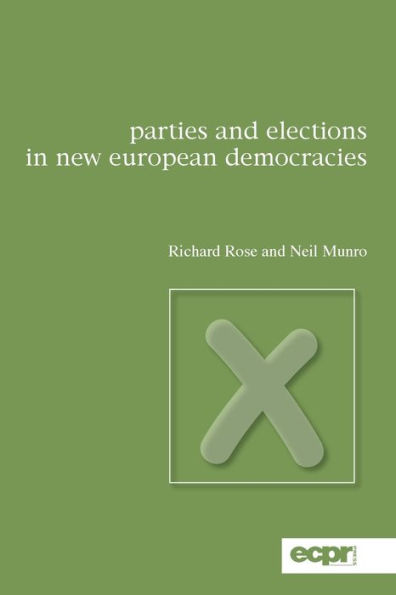Table of Contents
Preface: Understanding Elections ix
Part 1 The Framework of Competition
1 Elite Supply and Mass Response: An Interactive Model 1
Democratization Backwards-and in a Hurry 2
Understanding Election Outcomes 6
2 Electoral Systems Compared 10
Electing Representatives 10
Effects of Electoral Systems 17
3 Parties Without Civil Society 22
A Big Supply of Parties 23
Competition Along Multiple Dimensions 29
4 Voters Without Trust 34
A Legacy of Distrust 35
Political Values Without Parties 38
5 Competition Without Institutionalization 43
Institutionalization in Theory 44
Stable Election Laws 46
Floating Systems of Parties 47
Institutionalizing an Incomplete Democracy 54
References 58
Part 2 National Election Results
Conventions in Reporting Results 66
6 Bulgaria 67
7 Czechoslovakia 84
8 Czech Republic 99
9 Slovakia 113
10 Estonia 129
11 Hungary 144
12 Latvia 157
13 Lithuania 173
14 Poland 191
15 Romania 210
16 Slovenia 230
17 Russia 246
Tables and Figures
Part 1
Figure 1.1 From first free election to European Union entry 5
Figure 1.2 Interactive model of election outcomes 9
Table 2.1 Characteristics of electoral systems 12
Table 2.2 Influences on turnout 18
Table 2.3 Proportionality between votes and seats 19
Table 2.4 Influences on proportionality 20
Figure 3.1 Number of parties by country since 1990 25
Figure 3.2 Average number of parties in an election 27
Table 4.1 Distrust in parties high 36
Figure 4.1 No party the most popular choice 37
Table 4.2 Political outlooks of the electorate 40
Figure 5.1 Few parties show stamina to persist since 1990 48
Figure 5.2 Volatility of vote: founding and latest elections 51
Figure 5.3 Supply-side actions chief cause of volatility 52
Table 5.1 Getting rid of elections unlikely 56
Part 2
Table 6.1 Bulgarian Political Parties 70
6.2a-d Presidential Votes: 1992-2006 73-75
6.3a Votes for the Narodno Sobranie 76
6.3b Percentage of Votes for the Narodno Sobranie 78
6.3c Number of Seats in the Narodno Sobranie 80
6.3d Percentage of Seats in the Narodno Sobranie 82
Table 7.1 Czechoslovak Political Parties, 1990-1992 87
7.2a Votes for the Sn?movna Lidu 90
7.2b Percentage of Votes for the Sn?movna Lidu 92
7.2c Number of Seats in the Sn?movna Lidu 94
7.2d Percentage of Seats in the Sn?movna Lidu 96
Table 8.1 Czech Political Parties 101
8.2a Votes for the Narodn? Rada 1990-1992 and Poslaneck? Sn?movna 1996 104
8.2b Percentage of Votes for the Narodn? Rada 1990-1992 and Poslaneck? Sn?movna 1996 106
8.2c Seats in the Narodn? Rada 1990-1992 and Poslaneck? Sn?movna 1996- 108
8.2d Percentage of Seats in the Narodn? Rada 1990-1992 and Poslaneck? Sn?movna 1996 110
Table 9.1 Slovak Political Parties 115
9.2a-b Presidential Votes: 1999, 2004 118-19
9.3a Votes for the N?rodn? Rada 120
9.3b Percentage of Votes for the N?rodn? Rada 122
9.3c Seats in the N?rodn? Rada 124
9.3d Percentage of Seats in the N?rodn? Rada 126
Table 10.1 Estonian Political Parties 133
10.2 Presidential Vote: 1992 135
10.3a Votes for the Riigikogu 136
10.3b Percentage of Votes for the Riigikogu 138
10.3c Number of Seals in the Riigikogu 140
10.3d Percentage of Seats in the Riigikogu 142
Table 11.1 Hungarian Election: 4 November 1945 145
11.2 Hungarian Political Parties 147
11.3a Votes for the Orsz?ggy?l?s 150
11.3b Percentage of Votes for the Orsz?ggy?l?s 152
11.3c Number of Seats in the Orsz?ggy?l?s 153
11.3d Percentage of Seats in the Orsz?ggy?l?s 155
Table 12.1 Latvian Political Parties 160
12.2a Votes for the Saeima 164
12.2b Percentage of Votes for the Saeima 166
12.2c Number of Seats in the Saeima 168
12.2d Percentage of Seats in the Saeima 170
Table 13.1 Lithuanian Political Parties 175
13.2a-d Presidential Votes: 1993-2004 179-81
13.3a Votes for the Seimas 182
13.3b Percentage of Votes for the Seimas 184
13.3c Number of Seats in the Seimas 186
13.3d Percentage of Seats in the Seimas 188
Table 14.1 Polish Constitutional Referendum, 25 May 1997 194
14.2 Polish Political Parties 195
14.3a-d Presidential Votes: 1990-2005 199-201
14.4a Votes for the Sejm 202
14.4b Percentage of Votes for the Sejm 204
14.4c Number of Seats in the Sejm 206
14.4d Percentage of Seats in the Sejm 208
Table 15.1 Romanian Political Parties 215
15.2a-e Presidential Votes: 1990-2004 219-21
15.3a Votes for the Camera Deputatilor 222
15.3b Percentage of Votes for the Camera Deputatilor 224
15.3c Number of Seats in the Camera Deputatilor 226
15.3d Percentage of Seats in the Camera Deputatilor 228
Table 16.1 Slovenian Political Parties 233
16.2a-e Presidential Votes: 1990-2007 235-37
16.3a Votes for the Dr?avni Zbor 238
16.3b Percentage of Votes for the Dr?avni Zbor 240
16.3c Number of Seats in the Dr?avni Zbor 242
16.3d Percentage of Seats in the Dr?avni Zbor 244
Table 17.1 RSFSR Presidential Vote: 12 June 1991 248
17.2 Vote on Russian Constitution: 12 December 1993 249
Figure 17.1 Disproportionality in Duma Votes and Seats 257
Table 17.3 Russian Political Parties 261
17.4a-d Presidential Votes: 1996-2008 266-67
17.5a List Votes for the Duma 268
17.5b Votes in Single-Member Districts for the Duma 270
17.5c Number of Seats in the Duma 272
17.5d Percentage of Seats in the Duma 274



